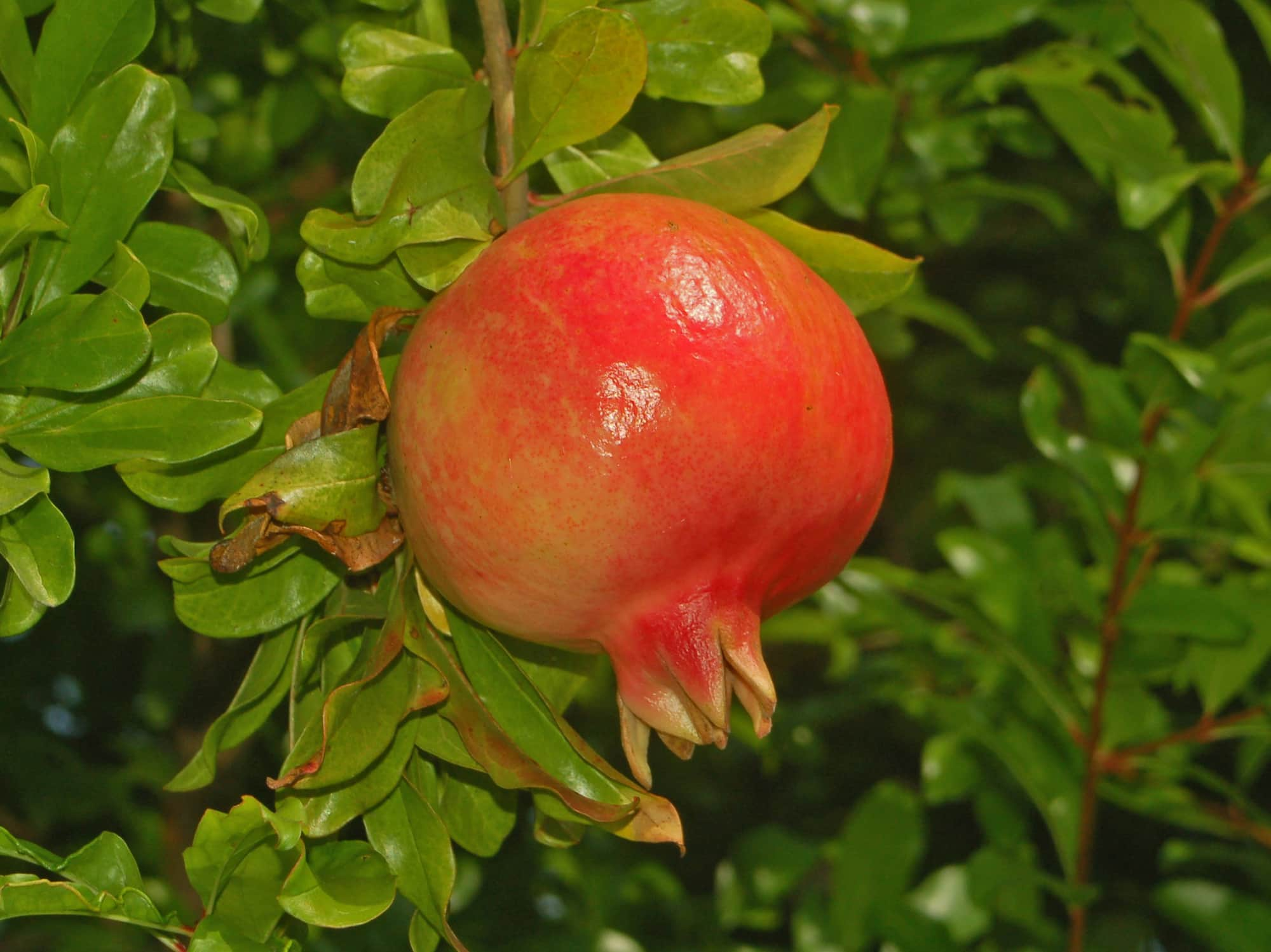
The pomegranate tree: planting, growing, harvesting
Contents
The fruiting pomegranate in a nutshell
- This small tree with a bushy habit boasts a spectacular and dazzling flowering
- Fruit set occurs from late September to late October
- The glossy green foliage that develops on thin shoots is particularly decorative
- Hardy down to -15 °C, the pomegranate withstands drought
- Growable in all soils, it thrives in open ground in the south of France, in pots elsewhere.
A word from our expert
The pomegranate tree (Punica granatum) is a small tree widely distributed in the south of France where it successfully bears fruit. A member of the Punicaceae family, this bush produces large fruits, coloured red or orange, at the very beginning of autumn, starting from its fourth year. Elsewhere in France, it adapts perfectly to pot cultivation to be wintered in a conservatory or greenhouse during winter.
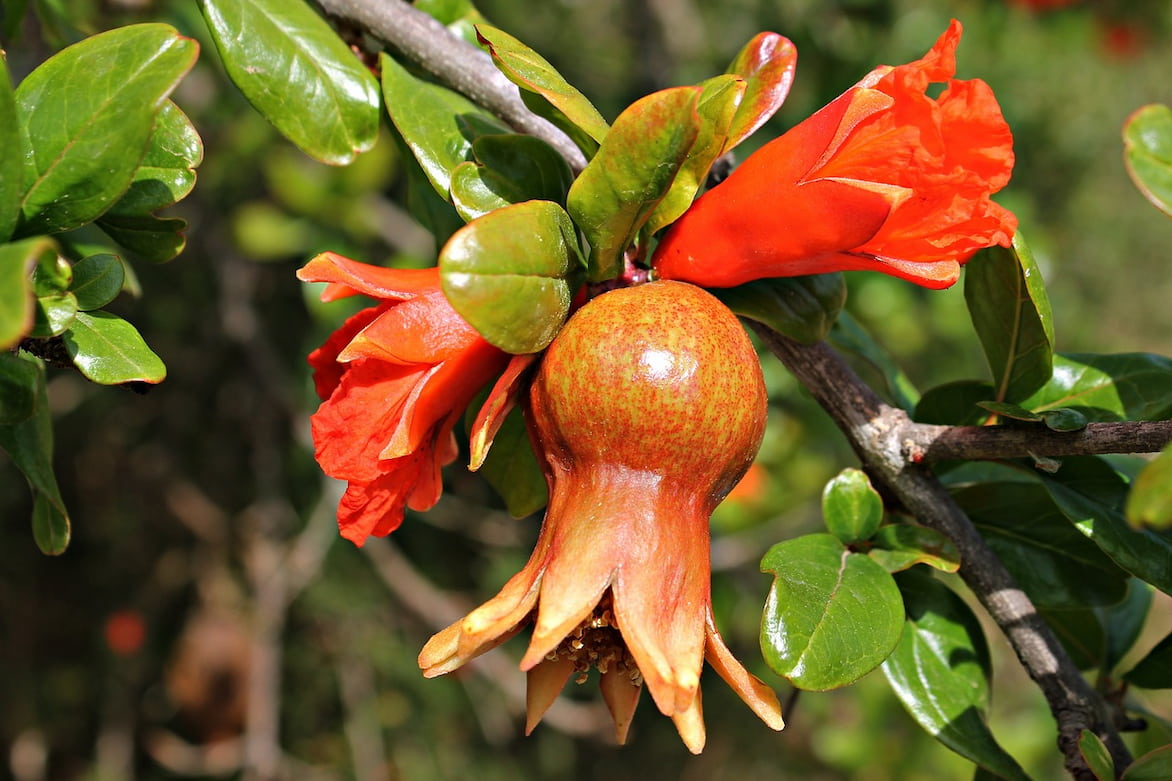
The pomegranate tree is ideal for planting in the south of France
But this fruit tree is also appreciated for its large bright orange to red flowers shaped like jugs, which are nectariferous and polliniferous.
As for its deciduous foliage, glossy green, it turns golden in autumn. Its young red shoots are also very decorative.
Not demanding on soil, this bush loves sun and warmth. It will need watering to bear fruit properly.
Botanical description
Botanical data
- Latin name Punica granatum
- Family Punicaceae
- Common name Common pomegranate, Punic apple, balonstier, balaustier, migranier in Provençal
- Flowering summer
- Height 4 to 5 metres
- Exposure sunny
- Soil type all soils
- Hardiness Hardiness down to -15 °C
The main representative of the Punicaceae family (now integrated into the Lythraceae family), which comprises only one genus (Punica) and two species, the fruiting pomegranate (Punica granatum) is a fruit tree widely cultivated from Iran to northern India, and more generally across tropical and subtropical countries. It has also naturalised in the south of France, where it fruits successfully.
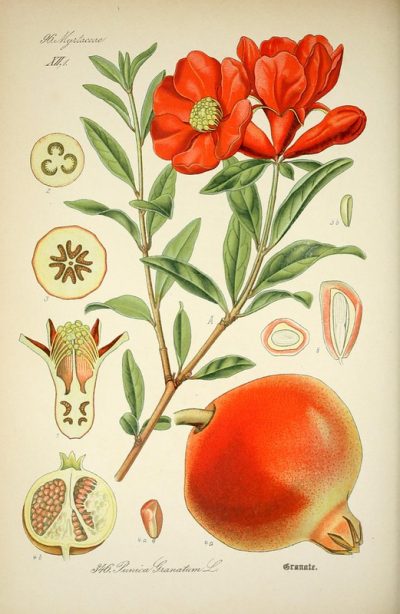
Punica granatum – Botanical illustration
Born in Persia over 5000 years ago, the pomegranate held a prominent place in the gardens of Babylon. A symbol of fertility, posterity, and eternity, the pomegranate is found in Egypt and also depicted in Byzantine mosaics. The Greeks often refer to its medicinal virtues and consider it a symbol of fertility. It was certainly the Phoenicians who introduced it to Africa, where the Romans discovered it in Carthage, hence its name “Punic apple” or “Carthaginian apple.” The pomegranate later arrived in Spain thanks to the Arabs. In short, throughout history, this precious fruit has appeared in numerous legends, beliefs, and religions, spreading from Asia to southern Europe, not to mention incursions into American territory.
Today, regarded as a “super-fruit,” rich in vitamins, minerals, and trace elements, the pomegranate is widely cultivated throughout the Mediterranean basin, particularly in Provence. The pomegranate tree indeed requires long periods of heat and a bit of cold in winter to fruit properly.
Punica granatum derives its name from the Latin “punicus,” meaning “of Carthage,” and “granatum,” meaning “filled with seeds.”
The fruiting pomegranate should not be confused with the flowering pomegranate, which is sterile and used as an ornamental bush due to its abundant flowering. The main difference between these two Punica granatum lies in the heart of their flowers. Those of the fruiting pomegranate are long-styled and develop in a jug shape, while the flowering pomegranate produces smaller, short-styled, bell-shaped flowers, whose gynoecium does not develop. They are therefore sterile.
The fruiting pomegranate is self-fertile.
With a fairly rapid growth until its first fruiting (around 4 or 5 years), the fruiting pomegranate grows more slowly afterwards but can reach a longevity of nearly 200 years. A small tree with a typically Mediterranean silhouette, it has a bushy, spreading, branched, and rather rounded habit. It can reach 6 m in height, but more reliably between 4 and 5 metres with a spread of 2 to 3 metres.
The bark of its trunk, light beige to grey, tends to crack as it ages. It bears thin, slender branches, often reddish, which carry fine thorns. The flowering pomegranate, on the other hand, is more inermous (thornless).
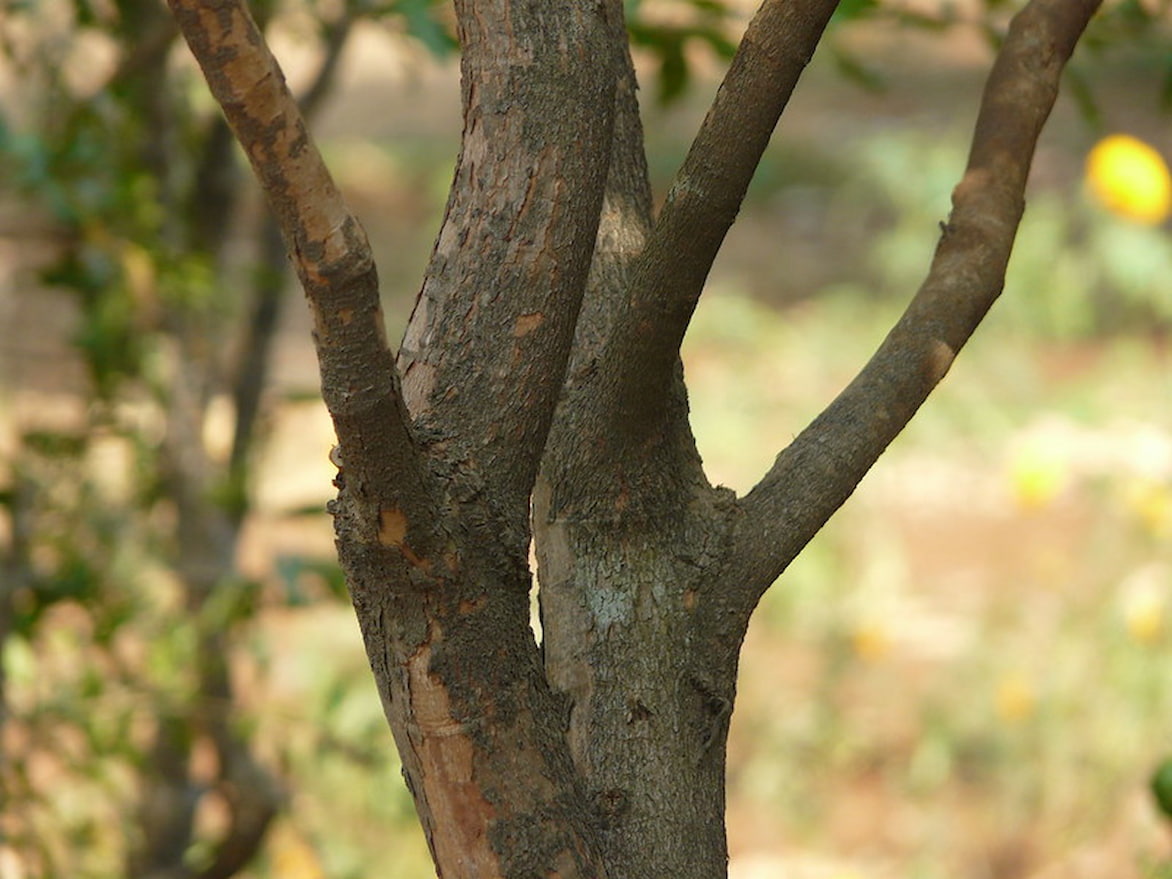
As it ages, the trunk of the fruiting pomegranate cracks
In spring, at the time of bud burst, the fruiting pomegranate adorns itself with very decorative young red shoots, which contrast with the foliage of the older branches. The foliage then becomes glossy green before turning purple, orange, and golden in autumn. In winter, the fruiting pomegranate is bare but still bears fruit, which presents undeniable ornamental interest.
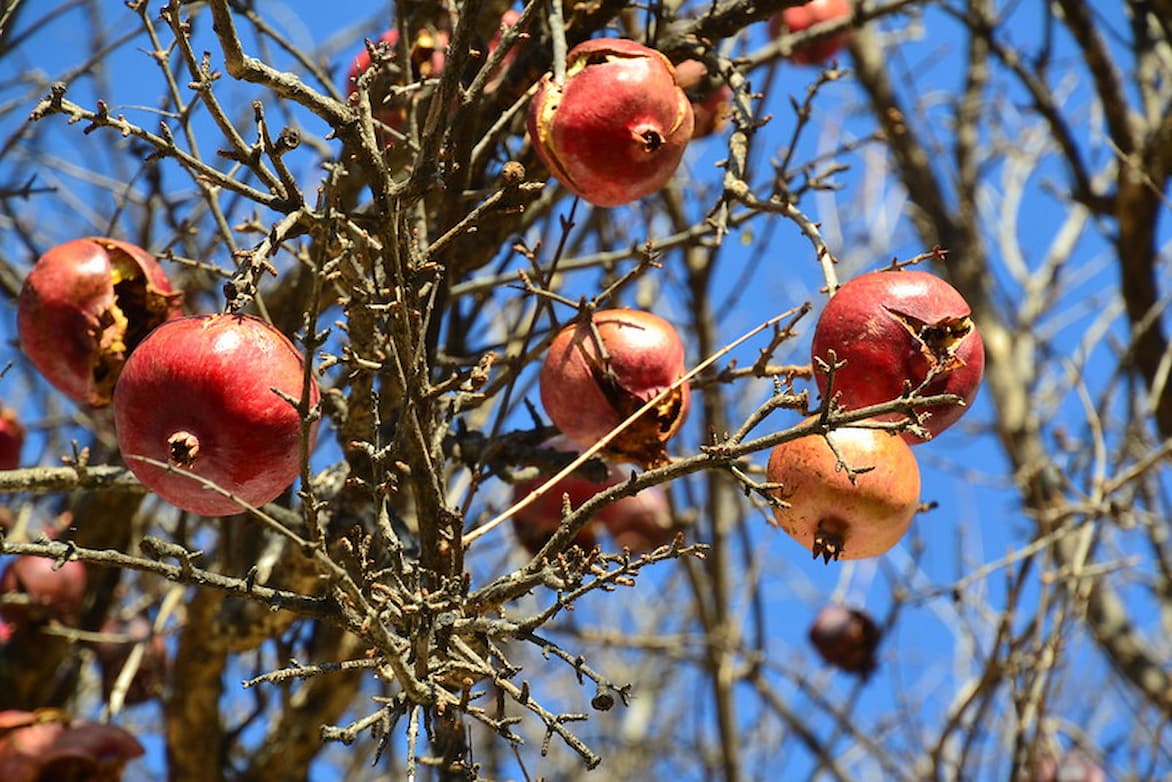
In winter, the bare branches still bear fruit, adding a certain charm to the fruiting pomegranate
The opposite, oblong, and lanceolate leaves, measuring about 4 to 8 cm, have a short petiole with a lovely reddish hue. The leaves of the fruiting pomegranate are most often whorled and equipped with a mucro (terminal point).
Flowering can occur from May to August depending on the varieties and climate, but is mainly concentrated in June and July. The different varieties of fruiting pomegranate generally offer an abundant flowering in orange-red.
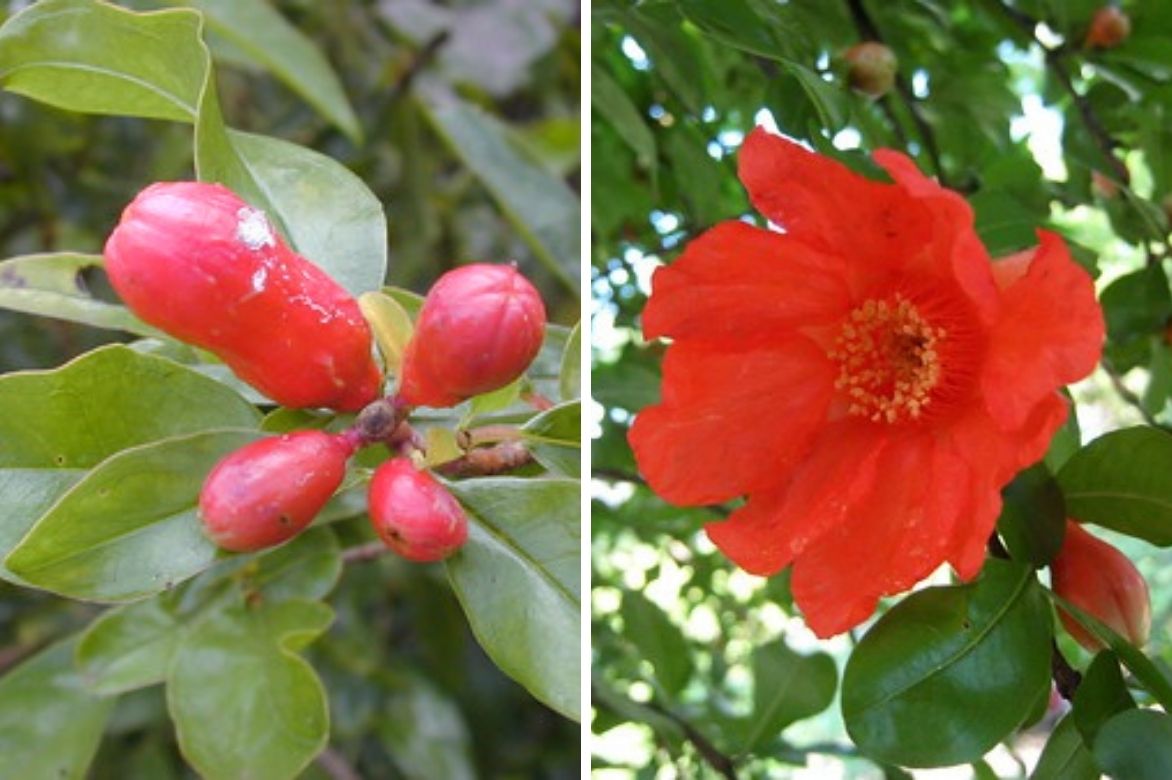
The flowers of the fruiting pomegranate are orange-red
The flowers, rather solitary in the fruiting pomegranate, are equipped with red stamens and slightly crumpled petals. With a short peduncle, the flowers resemble a jug due to their cylindrical and tubular calyx shape. Flowering only occurs on branches that are at least 2 years old.
Fruiting begins between the 3rd and 4th year. After that, the pomegranate will continue to produce fruit until its 20th year. The pomegranates reach ripeness between late September and early November. The pomegranate produces spherical fruits about 8 to 10 cm in diameter with a leathery pericarp. Depending on the varieties, they colour red, orange, sometimes yellow or purple.
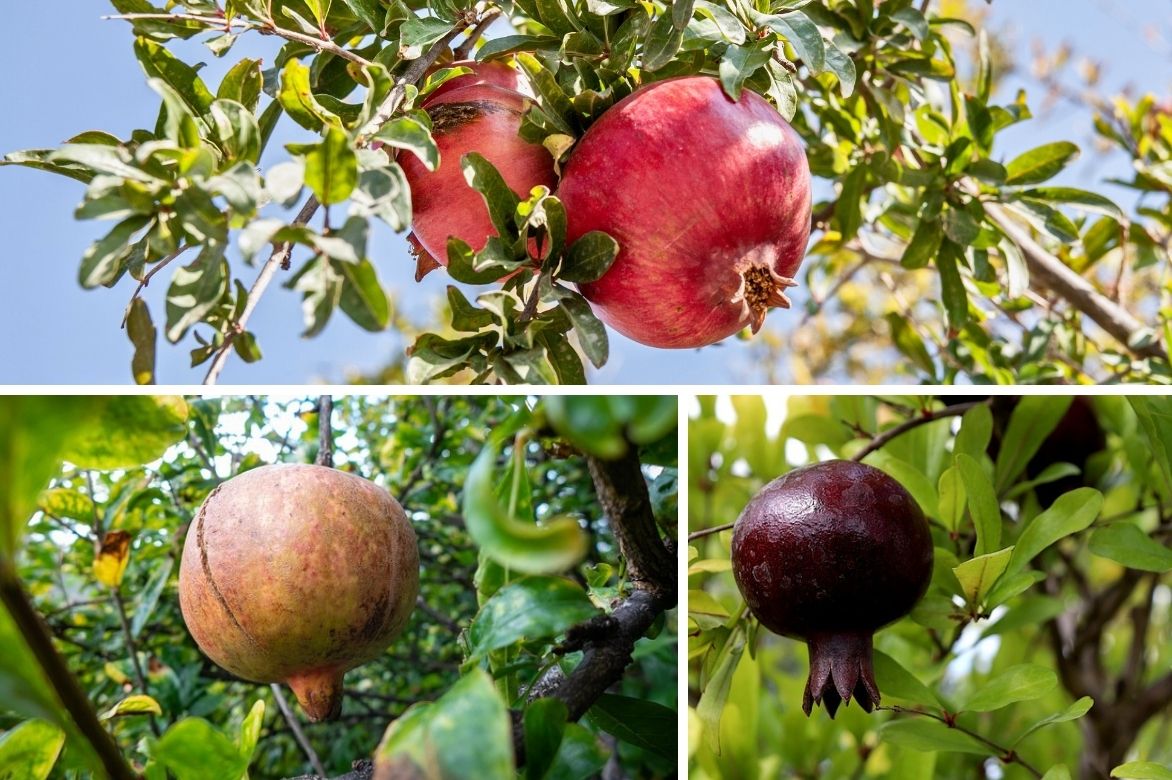
Depending on the varieties, pomegranates can be red, yellow washed with red, or even purple
Their skin is also leathery, and their pink pulp is juicy and slightly tangy. Each pomegranate consists of 6 to 12 chambers, separated by whitish membranes, which contain seeds called arils, more or less tender and acidic depending on the varieties.
Pomegranates are harvested when nearly ripe. They can be stored for 5 to 6 months in a dry, cool place. If left to ripen on the tree, they tend to split, being so full of sugar.
Overall, the fruiting pomegranate is hardy down to -15 °C. However, to fruit, it needs a lot of heat over a fairly long period, and a winter that is present but mild. Therefore, planting in the ground in the Midi is suitable for it. Elsewhere, fruiting may not be guaranteed. However, certain varieties can be planted in pots of at least 3 litres, stored in winter in a conservatory or cold greenhouse.
“`
The main varieties of pomegranate trees
The pomegranate tree commonly found in individual gardens across France is the Punica granatum ‘Provence’. This highly productive pomegranate variety bears fruit over a long period and is hardy down to -17°C. It features lovely single orange flowers and has a naturally bushy habit. As its seeds are relatively hard, this pomegranate can be grown for its juice.
The other most widespread variety is Punica granatum ‘Mollar de Elche’, which has bright orange single flowers and yellowish fruits washed with red. Its pulp is substantial, and its seeds are small and soft. It is hardy down to -12°C. Another common variety is Punica granatum ‘Fleshman’, a vigorous shrub that fruits early, between August and September, making it ideal for regions with shorter summers. The fruits are a good size, with small soft seeds.
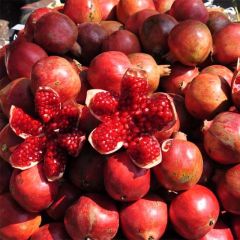
Punica granatum Wonderful - Pomegranate
- Flowering time June to August
- Height at maturity 4 m
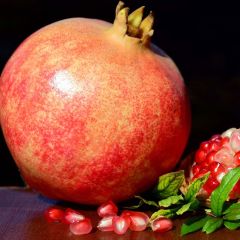
Punica granatum Malisi - Pomegranate
- Flowering time June to October
- Height at maturity 3 m
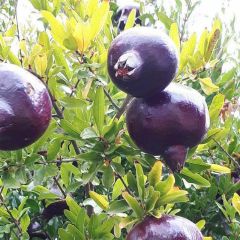
Punica granatum Black Fruit - Pomegranate
- Flowering time July to September
- Height at maturity 3,50 m
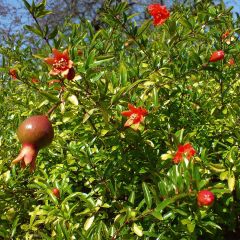
Punica granatum var. nana - Pomegranate
- Flowering time July to September
- Height at maturity 1 m
Discover other Punica - Pomegranate
View all →Available in 2 sizes
Available in 1 sizes
Available in 2 sizes
Available in 1 sizes
Available in 1 sizes
Available in 1 sizes
Available in 1 sizes
Available in 1 sizes
Available in 1 sizes
Available in 1 sizes
Planting the pomegranate tree
Where to plant?
The pomegranate is quite undemanding when it comes to soil. All types of soil suit it, including calcareous, arid, saline, or alkaline soils. Only clayey ground can be fatal for it. Therefore, drainage must be well managed, and the soil should be aerated. Some producers also acknowledge that the pomegranate thrives in moist ground, combined with good sunlight.
As for the chosen location, it should be sunny and sheltered from cold winds, such as by a wall. If these conditions are met, the pomegranate can surprise and bear fruit. However, for quality fruiting, a hot and lasting summer is required.
When to plant?
In the Mediterranean region, the pomegranate is planted in autumn so that the rooting occurs before the intense summer heat. Elsewhere, planting in early spring, from March to May depending on the climatic zones, is preferable.
How to plant?
- Remove the pomegranate from the pot and soak it in a bucket of water. You can also coat the roots in a mixture of water, manure, and soil.
- Dig a hole one metre in all directions, maintaining a distance of 4 metres between two plants.
- Drain the hole with gravel or sand.
- Add well-decomposed manure or compost on top of the gravel layer.
- Place the bush and fill the hole with the extracted soil.
- Firm the soil around the pomegranate.
- Water generously.
For planting the pomegranate in a pot:
- Choose a pot at least 60 cm deep, without a water reservoir.
- Cover the bottom with a 20 cm layer of gravel.
- Add some loamy garden soil and potting mix.
- Place the pomegranate, spreading out the roots.
- Finish filling the pot.
- Firm the soil.
- Water generously.
The care and pruning of the pomegranate tree
In the first two years, the water needs of the pomegranate are significant to ensure it roots properly and deeply in the soil. For older trees, watering remains regular as it facilitates fruiting. Additionally, the pomegranate seems to appreciate the coolness of certain soils, although it can adapt to drier soils.
In pots, the pomegranate should be watered generously every 10 days. Never allow standing water.
an application of fertiliser rich in nitrogen and phosphorus is recommended for the proper development of the pomegranate. In pots, the pomegranate will be fertilised with a fertiliser for fruit trees.
The fruiting of the pomegranate occurs on branches that are at least two years old, so pruning involves removing dead branches and poorly oriented branches. This takes place in February or March, every two years, only after 3 to 4 years post-planting. The pomegranate will have had time to root and form a natural clump. It also produces many suckers that should be removed at soil level.
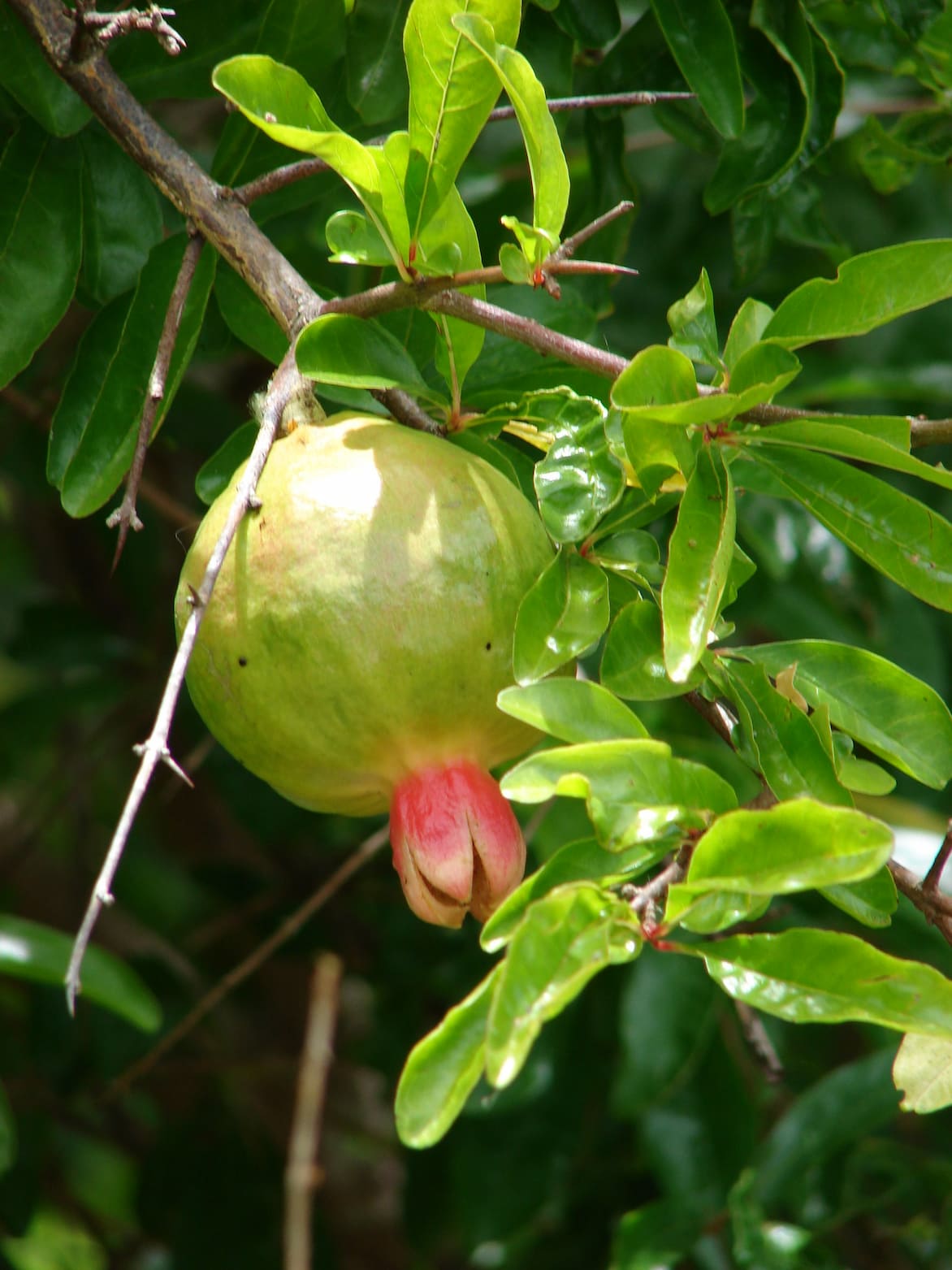 The first fruiting occurs in the 3rd or 4th year
The first fruiting occurs in the 3rd or 4th year
When the pomegranate is grown in a pot, it should be wintered in a conservatory or unheated greenhouse, but protected from frost. This period of winter cold is necessary for fruiting. From May onwards, take the pomegranate outside and place it in full sun.
Pests and Diseases of the Pomegranate Tree
In very humid areas, the pomegranate can be susceptible to a fungal disease caused by the fungus Aspergillus castaneus, which settles in the heart of the fruit and leads to its rotting. To prevent this, it is recommended to collect fallen fruits from the ground and allow the soil to dry out between waterings to avoid maintaining a form of humidity. Bordeaux mixture can be used for treatment in spring.
The pomegranate can also be attacked by aphids or red spider mites, which do not affect fruiting.
→ Learn more about the diseases and pests of the pomegranate in our advice sheet!
Multiplication
Multiplication by sowing is very unpredictable, with no guarantee of retaining the characteristics of the parent plant, and it is particularly lengthy. The simplest way to propagate a pomegranate remains the collection of suckers in autumn. Similarly, propagation is possible.
Propagation by Cuttings
Propagation by cuttings is done at the end of winter, from late February to early March. This involves taking one-year-old shoots, about the diameter of a pencil and 20 to 30 cm long. These shoots are most often located in the centre of the bush. Next, these cuttings are planted in a mixture of potting soil and garden soil. Half of the buds should be buried, with the other half above the substrate. Finish by lightly firming the soil and watering. The cuttings should be placed in light shade and protected from the wind. The substrate should remain slightly moist.
In spring or the following year, the young plants are transplanted into a nursery or pot and placed under a frame. They will remain there for 2 to 3 years before final planting.
→ Learn more about pomegranate propagation in our tutorial!
The harvest of pomegranates
Pomegranates are harvested from late August for the earliest varieties until November. The fruits are picked before they reach full ripeness, or just as they begin to split, before they burst open. They can be stored for up to 6 months. They decrease in size, shrivel slightly but gain in flavour.
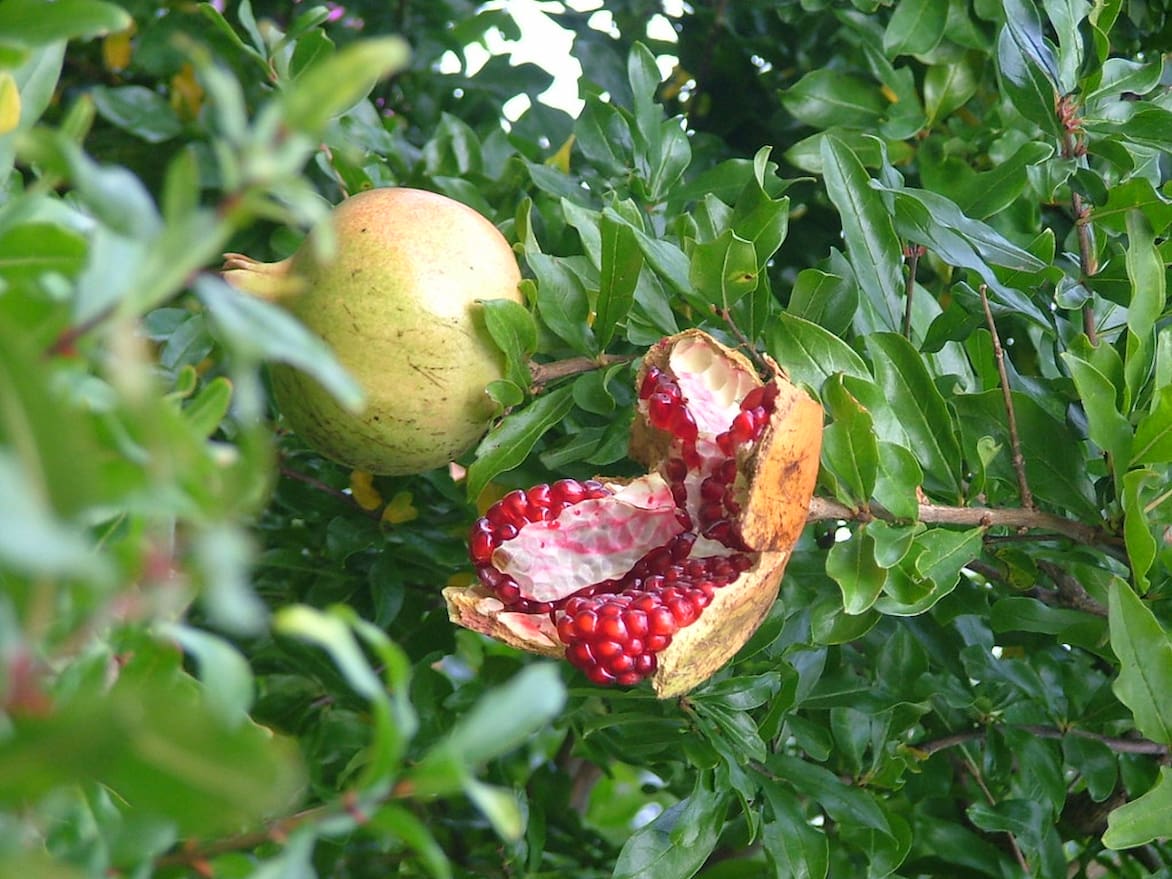 Overripe, pomegranates burst on the tree
Overripe, pomegranates burst on the tree
The pomegranate is a fruit with numerous benefits, used since antiquity as a medicinal plant. Rich in vitamins C, B5, B6, and B9, K, copper, and manganese, the pomegranate is especially known and recognised for its antioxidant content. It can be consumed as juice or simply cut in half with a small spoon. It can be added to a fruit salad or made into a sauce to accompany meat or fish.
How to associate the pomegranate tree with fruits?
The pomegranate tree is a fruit tree that thrives in a Mediterranean climate, so it can be planted alongside other fruit trees such as the pawpaw, the fig tree, the jujube, Poncirus trifoliata, or the mulberry.
It can also be planted alone in the centre of a flowerbed or in a large glazed pot placed on a Mediterranean-inspired terrace alongside a bougainvillea, a solanum, an eucalyptus, a Pittosporum Tobira ‘Nanum’, and a Miscanthus ‘Morning Light’. Not to mention citrus trees such as Citrus sinensis or Citrus madurensis (the Calamondin).
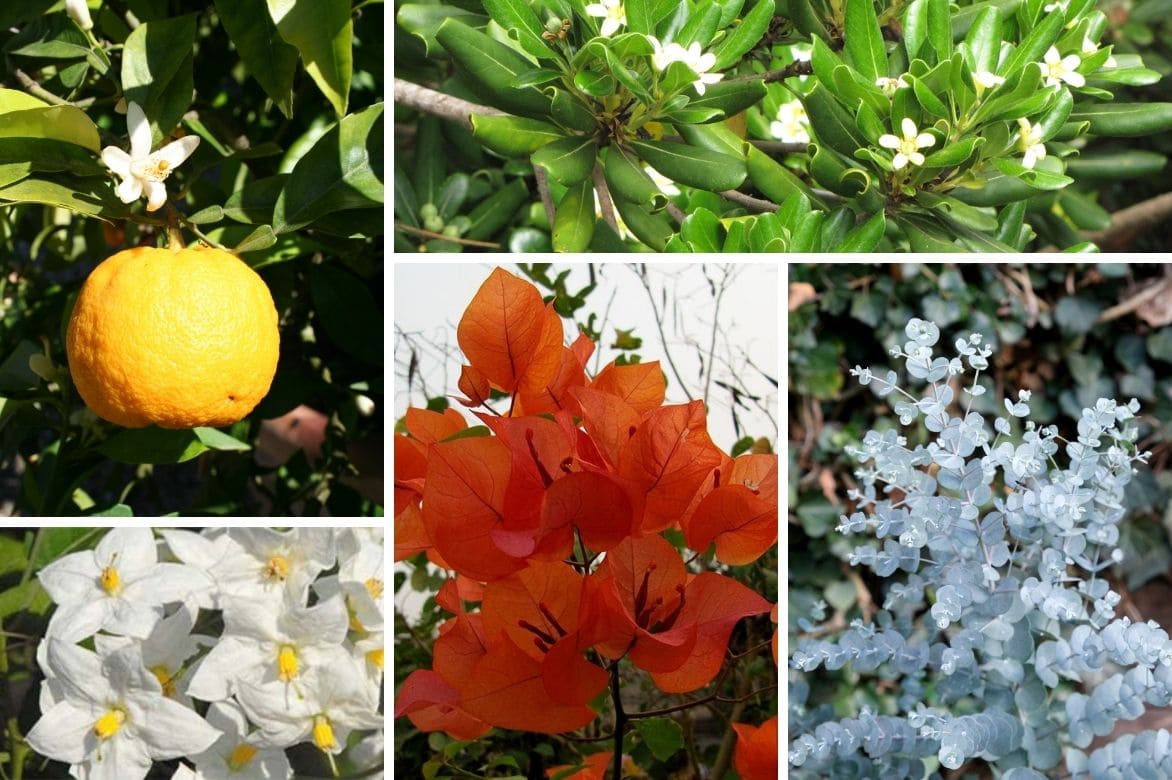
On a terrace, the pomegranate tree can be associated with a Citrus sinensis, a Solanum, a Pittosporum, a bougainvillea, and an eucalyptus.
It can also be paired with roses, jasmine, myrtles, lantanas…
Pomegranate and grenadine?
Ah, the grenadine syrup of our childhood! A true Proustian madeleine, this syrup with its vibrant red hue has nothing to do with pomegranate, as it is primarily made from red fruit juices, such as strawberries, raspberries, currants, or elderberries. So, one might wonder why this beverage is called “grenadine”? The term dates back to the 19th century and is simply the result of a marketing operation!
As for pomegranate syrup, it indeed exists. It is widely consumed in the Maghreb and Spain and is increasingly used in mixology for cocktail preparation.
→ Discover in the tutorial Ingrid’s recipe on How to make pomegranate syrup?
- Discover our selection of Mediterranean fruit trees
- The flowering pomegranate deserves a place in your garden: everything you need to know about its planting and cultivation
- Browse our advice sheet: How to grow a pomegranate in a pot?
- Why isn’t my pomegranate producing fruit? Discover our tips and solutions!
- Discover the best varieties of fruiting pomegranates
- Subscribe!
- Contents
































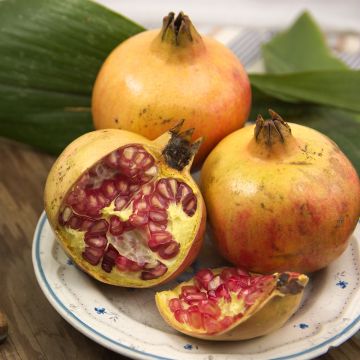

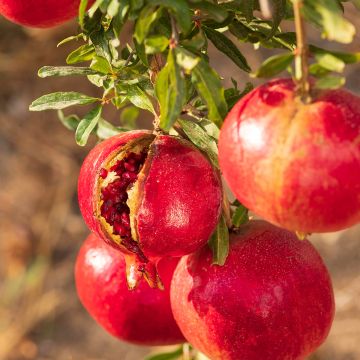
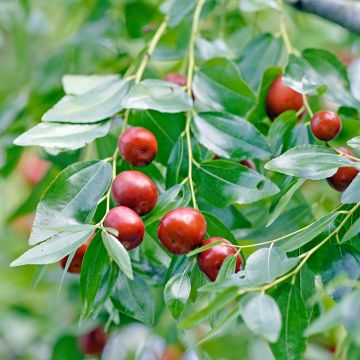
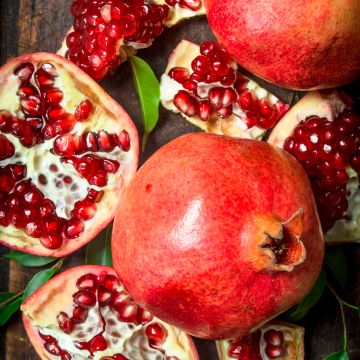


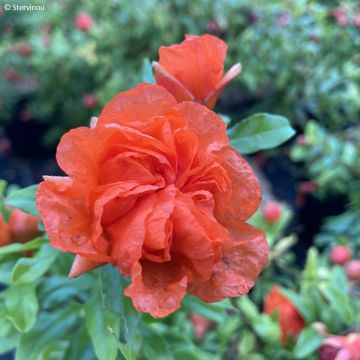
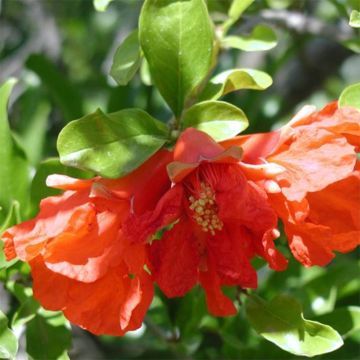
Comments